“Over Germany—1915″ by C. Heurlin
THIS week we present a cover by Colcord Heurlin! Heurlin worked in the pulps primarily over a ten year period from 1923 to 1933. His work appeared on Adventure, Aces, Complete Stories, Everybody’s Combined with Romance, North-West Stories, The Popular, Short Stories, Sky Birds, Sea Stories, Top-Notch, War Stories, Western Story, and here, the cover of the May 1931 Flying Aces!
Over Germany—1915
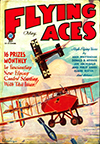 SUCH a scene as that depicted on our cover this month could have happened only in the early part of the war. For the French bomber whose pilot you see sending a Boche plane down in flames while his observer drops missiles of death on German terrain is an old pusher-type Salmson that went out of use in 1915. At that time, the Fokker stormed the Front with a new type of machine gun that fired through the propeller, and this Salmson was too heavy and slow to compete. It had had its day of glory, however, for it was one of the earliest ships that were really battle-planes, in which the pilot and observer were protected by a metal-covered nacelle.
SUCH a scene as that depicted on our cover this month could have happened only in the early part of the war. For the French bomber whose pilot you see sending a Boche plane down in flames while his observer drops missiles of death on German terrain is an old pusher-type Salmson that went out of use in 1915. At that time, the Fokker stormed the Front with a new type of machine gun that fired through the propeller, and this Salmson was too heavy and slow to compete. It had had its day of glory, however, for it was one of the earliest ships that were really battle-planes, in which the pilot and observer were protected by a metal-covered nacelle.

“Over Germany—1915â€
Flying Aces, May 1931 by C. Heurlin
“Torpedoes for Trouble” by Colcord Heurlin
THIS week we present a cover by Colcord Heurlin! Heurlin worked in the pulps primarily over a ten year period from 1923 to 1933. His work appeared on Adventure, Aces, Complete Stories, Everybody’s Combined with Romance, North-West Stories, The Popular, Short Stories, Flying Aces, Sea Stories, Top-Notch, War Stories, Western Story, and here, the cover of the December 1931 Sky Birds!
Torpedoes for Trouble
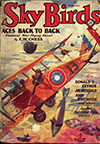 IT WAS a far cry from the early days of the war, when aviators were asked to drop bombs on hurriedly constructed Zeppelin hangars in northern Belgium, to the 1918 bomber with its aerial torpedo. In the early days airmen often made their own bombs of petrol cans wrapped with tarred rope which was designed to blast out hangars and then set fire to the remains. From those days bombing went through the 20-pounder stage, automatic racks, and eventually blossomed out with ships carrying single 550-pound missiles designed to fang their way through many feet of solid concrete before exploding. These were known as delayed detonation bombs.
IT WAS a far cry from the early days of the war, when aviators were asked to drop bombs on hurriedly constructed Zeppelin hangars in northern Belgium, to the 1918 bomber with its aerial torpedo. In the early days airmen often made their own bombs of petrol cans wrapped with tarred rope which was designed to blast out hangars and then set fire to the remains. From those days bombing went through the 20-pounder stage, automatic racks, and eventually blossomed out with ships carrying single 550-pound missiles designed to fang their way through many feet of solid concrete before exploding. These were known as delayed detonation bombs.
On this month’s cover we show a two-seater bomber of this type. It has just released a 550-pound torpedo over a German airdrome. As in this picture, the pilot usually dived his ship on the target as though he were going to fire his fixed guns, and then released the torpedo-bomb. The spinning projectile did the rest.

“Torpedoes for Trouble”
Sky Birds, December 1931 by Colcord Heurlin
“The High Sign” by Colcord Heurlin
THIS week we present another cover by Colcord Heurlin! Heurlin worked in the pulps primarily over a ten year period from 1923 to 1933. His work appeared on Adventure, Aces, Complete Stories, Everybody’s Combined with Romance, North-West Stories, The Popular, Short Stories, Sky Birds, Sea Stories, Top-Notch, War Stories, Western Story, and here, the cover of the September 1931 Flying Aces!
The High Sign
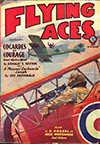 SURRENDER in the air! It often happened when some one got the breaks. And often it was planned for when the Allies wanted a special type of German machine.
SURRENDER in the air! It often happened when some one got the breaks. And often it was planned for when the Allies wanted a special type of German machine.
On the occasion depicted on our cover this month, a German two-seater of new design has had its prop shattered and its crew is helpless over Allied territory. It would have been easy for the man in the Allied scout plane to shoot them down, but he preferred to take them whole.
He signaled to the enemy airmen to land and the observer indicated that he had seen, by holding his hands high and well away from his gun. The rest was easy—a complete German ship to study and a clear confirmation for the victorious pilot.
This cover is a reproduction of an actual incident. A photograph owned by one of our authors will confirm it.

“The High Sign”
Flying Aces, September 1931 by Colcord Heurlin
“His Last Salute” by Colcord Heurlin
THIS week we present a cover by Colcord Heurlin! Heurlin worked in the pulps primarily over a ten year period from 1923 to 1933. His work appeared on Adventure, Aces, Complete Stories, Everybody’s Combined with Romance, North-West Stories, The Popular, Short Stories, Sky Birds, Sea Stories, Top-Notch, War Stories, Western Story, and here, the cover of the August 1931 Flying Aces!
His Last Salute
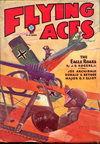 THE chivalry of the clouds—the code that persisted even in moments of grim tragedy—is depicted on this month’s cover. The German plane, riddled by Allied bullets, is going down—a flaming coffin. Its pilot, about to take the leap that means death, turns to make one last gesture—a salute to the Allied pilot who has sent him down—and his conqueror answers the salute. Fighting for different causes though they were, those two airmen, like all the true knights of the air, held one thing highest—Courage, in life or in death!
THE chivalry of the clouds—the code that persisted even in moments of grim tragedy—is depicted on this month’s cover. The German plane, riddled by Allied bullets, is going down—a flaming coffin. Its pilot, about to take the leap that means death, turns to make one last gesture—a salute to the Allied pilot who has sent him down—and his conqueror answers the salute. Fighting for different causes though they were, those two airmen, like all the true knights of the air, held one thing highest—Courage, in life or in death!

“His Last Salute”
Flying Aces, August 1931 by Colcord Heurlin
“Bombers Down!” by Colcord Heurlin
THIS week we have a cover by the great Colcord Heurlin! He provided covers throughout the 1920’s and early 30’s for various pulp magazines—most frequently for your Adventure type magazines. Here we present his cover for the March 1931 issue of Flying Aces—a dynamic cover that once again has a story to tell.
Bombers Down!
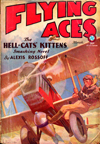 NOT all the danger attending the life of a bombardment pilot was crammed into the few mad minutes he spent over his objective, dodging enemy anti-aircraft fire, intercepting aircraft or the betraying beams of searchlights while his observer pulled the toggles that released the grim eggs. There was the dangerous take-off with a loaded plane. There was the wild flight across the line through the barrage of steel that vomited up from anti-aircraft batteries, and then, above all, there was the flight back.
NOT all the danger attending the life of a bombardment pilot was crammed into the few mad minutes he spent over his objective, dodging enemy anti-aircraft fire, intercepting aircraft or the betraying beams of searchlights while his observer pulled the toggles that released the grim eggs. There was the dangerous take-off with a loaded plane. There was the wild flight across the line through the barrage of steel that vomited up from anti-aircraft batteries, and then, above all, there was the flight back.
To carry high explosive was no cinch at the best of times, and many a pilot lost pounds in weight or added years to his age as he sat in the ship carrying the dangerous missiles. Once over the objective, they could get rid of the stuff and heave a sigh of relief. But—suppose the bomb rack jammed and left the bombs hanging by a lone loop. Suppose the observer yanked and pulled on the toggles in an effort to get it off, anyway and anywhere at all, with no success.
This has happened on several occasions, and generally speaking, the airmen are in a tight position. They cannot land with the bomb hanging in that manner. With the nose portion clear of the rack, as is shown in this month’s illustration, the wind vane has been released and the percussion pin has been wound into concussion position. All it requires is a slight jounce, and the 500-pound shell of T.N.T. is touched off. There is nothing to do but try and get the shell off somehow. Many an observer today is wearing a ribbon on his old flying tunic for getting out and releasing a bomb from a rack that has jammed. Sometimes it is easy. Sometimes the observer has had to get down on the landing gear and actually file the release pin off, or even shoot it away with an automatic.
There were times when it was done successfully. There were many when they were unable to release it before their gas supply ran out.
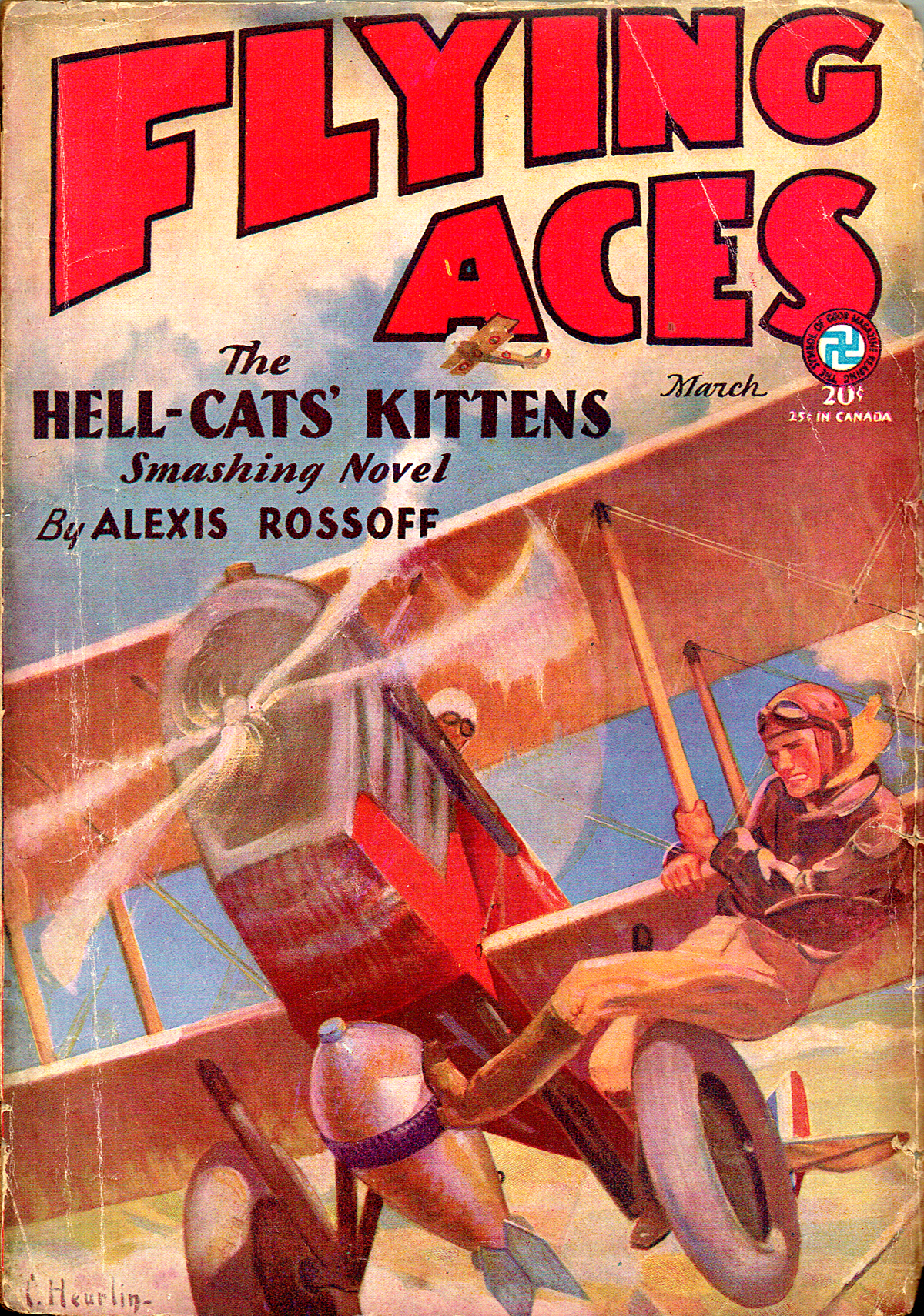
“Bombers Down!â€
Flying Aces, March 1931 by Colcord Heurlin
 SUCH a scene as that depicted on our cover this month could have happened only in the early part of the war. For the French bomber whose pilot you see sending a Boche plane down in flames while his observer drops missiles of death on German terrain is an old pusher-type Salmson that went out of use in 1915. At that time, the Fokker stormed the Front with a new type of machine gun that fired through the propeller, and this Salmson was too heavy and slow to compete. It had had its day of glory, however, for it was one of the earliest ships that were really battle-planes, in which the pilot and observer were protected by a metal-covered nacelle.
SUCH a scene as that depicted on our cover this month could have happened only in the early part of the war. For the French bomber whose pilot you see sending a Boche plane down in flames while his observer drops missiles of death on German terrain is an old pusher-type Salmson that went out of use in 1915. At that time, the Fokker stormed the Front with a new type of machine gun that fired through the propeller, and this Salmson was too heavy and slow to compete. It had had its day of glory, however, for it was one of the earliest ships that were really battle-planes, in which the pilot and observer were protected by a metal-covered nacelle.












